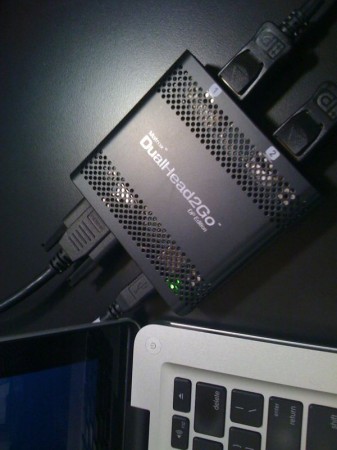Matrox is global leader in designing enterprise and industrial graphics solutions for a diverse array of industries, including financial, oil and gas, medical imaging, sciences, digital media, and engineering. The company has a series of Graphic eXpansion Modules (GXM) which enable mobile laptops to power either two or three large LCD displays in addition to its own display. In addition to powering additional monitors for Apple Mac and Windows based mobile computers the same GXM units can add display expansion for desktops and servers.
Advertisement
Matrox GXM Options for the Mac Platform
There are two key products that can serve the entire current line of Mac computers: Matrox DualHead2Go DP Edition and Matrox TripleHead2Go DP Edition. In this review we took a look at the DualHead2Go DP Edition GXM unit (see image 01). And we tested it on a mid-year 2009 MacBook (MacBook 5,1) with a 2 GHz Intel Core Duo processor and Nvidia GeForce 9400M graphics chip with 256 MB of memory.
For older Macs that do not use the Mini DisplayPort Maxtrox has both a digital and analog series of products (Matrox DualHead2Go Digital Edition and Matrox TripleHead2Go Digital Edition; and Matrox DualHead2Go Analog Edition and Matrox TripleHead2Go Analog Edition, respectively) to serve you. And in addition to these products video professionals on the Mac can also be served up more Mac friendly hardware that work in conjunction with these units.

01 – DualHead2Go GXM unit. As you can see next to an aluminum 2009 MacBook the unit is relatively tiny, perfect for carrying with you on business travel if need be.
The unit itself is a smallish, black metal box of punched-holed metal about 4 x 5 x 1.5 inches total–very discreet, tidy and attractive. On one side consists display ports and on the opposite side a USB port for powering the unit and another single DisplayPort. (see image 01 above) Standard items shipping with the unit include DisplayPort to DisplayPort input cable, USB cable for powering the device from your computer and the Getting Started CD.
There are two key things you will need to get started. First, you will need a Mini DisplayPort to DisplayPort adapter cable if you are using a Mac (such as a MacBook). This is sold separately for about 35.USD. Secondly, you will need to download the Matrox PowerDesk software for Mac in order to fully configure the product. The PowerDesk software for Mac installs key software and a new Matrox control panel to your Mac’s preferences. (see image 03 below)
The Matrox PowerDesk software for Mac comes in a standard OS X installer package and provides you with various settings organized across three windows. This is a native OS X application and sits inside your Applications folder. Once opened you can access the Matrox GXM Control Panel, which is also accessible from within your System Preferences, from inside the PowerDesk app.
Next page: Configuring the Unit




Reader Comments
Gosh, well I’ve seen the matrox advert on your site for a while and I had a look at it because on the surface it appears to be just what I need. Reading your review would have ‘confirmed’ it for me.
But BUYER BEWARE. This device is a complete non-starter for me because it does not support the currently shipping apple cinema displays (27in) – not even the last generation (24in).
Matrox website: “Supports a maximum resolution of 3840×1200 (2x 1920×1200); displays attached to DualHead2Go must run at the same resolution”
… therefore the setup described in the review – 2x 20in displays is as good as it gets. Unfortunately Apple stopped selling those displays almost 2 years ago.
1920 x 1200 is really not that much. A 17in macbook pro can do that on its own.
The DualHead2Go unfortunately is an outdated product – not worth 4.5/5
[…] This post was mentioned on Twitter by Anthony Frausto, Anthony Frausto. Anthony Frausto said: We have a new feature product review on Matrox's DualHead2Go DP Edition graphics expansion module–multi display for A…http://lnkd.in/Tmud42 […]
I wonder why my comment has not been approved?
I wonder why my comment has not been approved?
amonie,
Your comment(s) were merely sitting in moderation, nothing more. Busy times this month! As for your comments above, this is a really good observation and I have brought this to the attention of Matrox and am awaiting a comment on this issue. As for the Cinema Display limits mentioned in the review and max resolution? Ideally this product works best with non-Apple displays (larger than 20-inch) where resolution options are supported. Apple displays lock to just the one resolution of that display, even though you can typically scale down resolutions on Apple Cinema Displays. Do you really feel that 3840x wide is limiting coming off a laptop?
Amonie,
Just wanted to clarify some items related to your post. Spoke to Matrox about these issues you have raised. It is true that Apple’s display scenario is extremely limiting at the moment; you can only get one monitor…the 27-inch Cinema Display. That unit is $1000 and has a max resolution of 2560×1440 (its default). If you are looking for double that resolution (5120×1440) across two of these babies boy are you ambitious! Sounds dreamy but at two grand…sounds rich for CAD?
A better scenario and one I should have emphasized more in the review is to NOT use Apple Cinema Displays unless you have older ones like I do. Instead, a Dell UltraSharp 24-inch (U2410) with IPS technology is not only physically much larger than my twin 20-inch units but offers 1920×1200 pixels across each screen and will maximize the Matrox GXM unit reviewed. And it will do so for $800 less than buying two 27-inch Cinema Displays. Two of these units means nearly 2000 pixels for each application running off the Matrox GXM unit displays plus you still have your laptop’s display for other applications.
Also, Matrox says the last generation (2008) Cinema Displays 24-inch does indeed support the 1920×1200 resolution. Apple concurs. http://support.apple.com/kb/SP502
To clarify for readers the Cinema Displays that will work nicely with the product reviewed would be two of either of these:
2008 – Apple Cinema Display – 24-inch (2x1920x1200)
http://support.apple.com/kb/SP502
2004 – 20 and 23-inch Apple Cinema Displays (2x1680x1050 {tested setup} or 2x1920x1200 in the 23-inch)
http://support.apple.com/kb/SP79
This last product uses DVI so the other GXM units referenced should support this.
This is not a guarantee by Architosh. Our understanding of the spec literature tells us these units should be supported. Inquire directly with Matrox for exact product support coverage.
Again, for increased flexibility we recommend non Apple Displays which will give you choices in your resolution settings with the GXM units.
Dell and Eizo (http://www.eizo.com) are good recommendations for monitors for your Macs. We hope that Apple will improve its monitor options in the future.
Thanks for the clarification
Thanks for the clarification
Comments are closed.